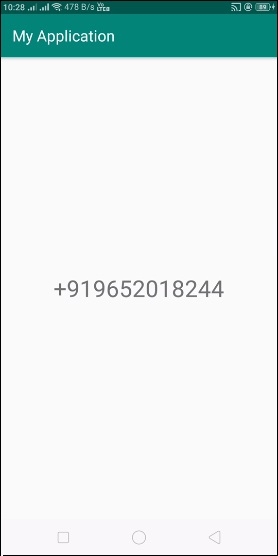
 Data Structure
Data Structure Networking
Networking RDBMS
RDBMS Operating System
Operating System Java
Java MS Excel
MS Excel iOS
iOS HTML
HTML CSS
CSS Android
Android Python
Python C Programming
C Programming C++
C++ C#
C# MongoDB
MongoDB MySQL
MySQL Javascript
Javascript PHP
PHP
- Selected Reading
- UPSC IAS Exams Notes
- Developer's Best Practices
- Questions and Answers
- Effective Resume Writing
- HR Interview Questions
- Computer Glossary
- Who is Who
How to get default phone number in android?
This example demonstrate about How to get default phone number in android.
Step 1 − Create a new project in Android Studio, go to File ⇒ New Project and fill all required details to create a new project.
Step 2 − Add the following code to res/layout/activity_main.xml.
<?xml version="1.0" encoding="utf-8"?> <LinearLayout xmlns:android="http://schemas.android.com/apk/res/android" xmlns:app="http://schemas.android.com/apk/res-auto" xmlns:tools="http://schemas.android.com/tools" android:layout_width="match_parent" android:gravity="center" android:layout_height="match_parent" tools:context=".MainActivity" android:orientation="vertical"> <TextView android:id="@+id/text" android:textSize="30sp" android:layout_width="wrap_content" android:layout_height="wrap_content" /> </LinearLayout>
In the above code, we have taken a text view to show the phone number.
Step 3 − Add the following code to java/MainActivity.xml
package com.example.myapplication;
import android.Manifest;
import android.content.Context;
import android.content.pm.PackageManager;
import android.os.Bundle;
import android.support.annotation.NonNull;
import android.support.v4.app.ActivityCompat;
import android.support.v7.app.AppCompatActivity;
import android.telephony.TelephonyManager;
import android.widget.TextView;
import static android.Manifest.permission.READ_PHONE_NUMBERS;
import static android.Manifest.permission.READ_PHONE_STATE;
import static android.Manifest.permission.READ_SMS;
public class MainActivity extends AppCompatActivity {
private static final int PERMISSION_REQUEST_CODE = 100;
TextView textView;
TelephonyManager telephonyManager;
@Override
protected void onCreate(Bundle savedInstanceState) {
super.onCreate(savedInstanceState);
setContentView(R.layout.activity_main);
textView = findViewById(R.id.text);
telephonyManager = (TelephonyManager) this.getSystemService(Context.TELEPHONY_SERVICE);
if (ActivityCompat.checkSelfPermission(this, READ_SMS) != PackageManager.PERMISSION_GRANTED &&
ActivityCompat.checkSelfPermission(this, READ_PHONE_NUMBERS) !=
PackageManager.PERMISSION_GRANTED && ActivityCompat.checkSelfPermission(this,
READ_PHONE_STATE) != PackageManager.PERMISSION_GRANTED) {
ActivityCompat.requestPermissions(this, new String[]{READ_SMS, READ_PHONE_NUMBERS, READ_PHONE_STATE}, PERMISSION_REQUEST_CODE);
} else {
textView.setText(telephonyManager.getLine1Number());
}
}
@Override
public void onRequestPermissionsResult(int requestCode, @NonNull String[] permissions, @NonNull int[] grantResults) {
super.onRequestPermissionsResult(requestCode, permissions, grantResults);
switch (requestCode) {
case PERMISSION_REQUEST_CODE:
if (ActivityCompat.checkSelfPermission(this, Manifest.permission.READ_SMS) !=
PackageManager.PERMISSION_GRANTED && ActivityCompat.checkSelfPermission(this,
Manifest.permission.READ_PHONE_NUMBERS) != PackageManager.PERMISSION_GRANTED &&
ActivityCompat.checkSelfPermission(this, Manifest.permission.READ_PHONE_STATE) !=
PackageManager.PERMISSION_GRANTED) {
return;
} else {
textView.setText(telephonyManager.getLine1Number());
}
}
}
}
Step 3 − Add the following code toAndroidManifest.xml
<?xml version="1.0" encoding="utf-8"?> <manifest xmlns:android="http://schemas.android.com/apk/res/android" package="com.example.myapplication"> <uses-permission android:name="android.permission.READ_PHONE_NUMBERS" /> <uses-permission android:name="android.permission.READ_PHONE_STATE" /> <application android:allowBackup="true" android:icon="@mipmap/ic_launcher" android:label="@string/app_name" android:roundIcon="@mipmap/ic_launcher_round" android:supportsRtl="true" android:theme="@style/AppTheme"> <activity android:name=".MainActivity"> <intent-filter> <action android:name="android.intent.action.MAIN" /> <category android:name="android.intent.category.LAUNCHER" /> </intent-filter> </activity> </application> </manifest>
Let's try to run your application. I assume you have connected your actual Android Mobile device with your computer. To run the app from android studio, open one of your project's activity files and click Run ![]() icon from the toolbar. Select your mobile device as an option and then check your mobile device which will display your default screen –
icon from the toolbar. Select your mobile device as an option and then check your mobile device which will display your default screen –

Click here to download the project code

